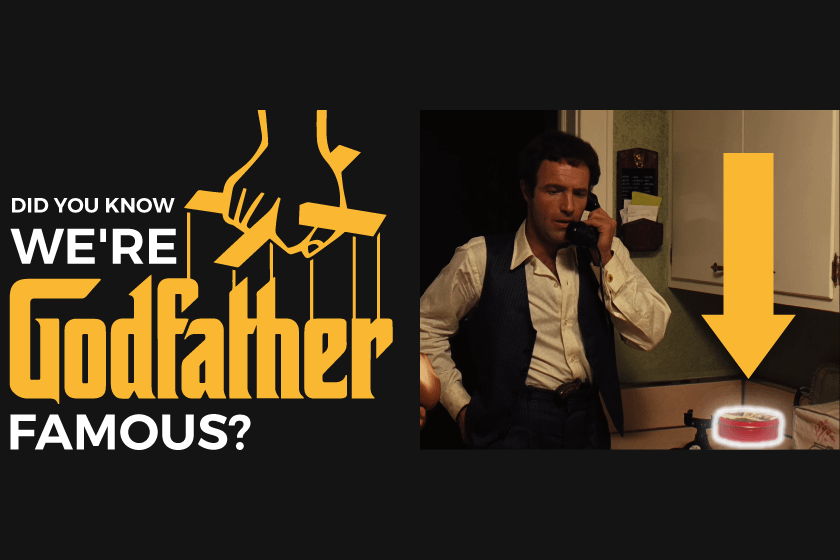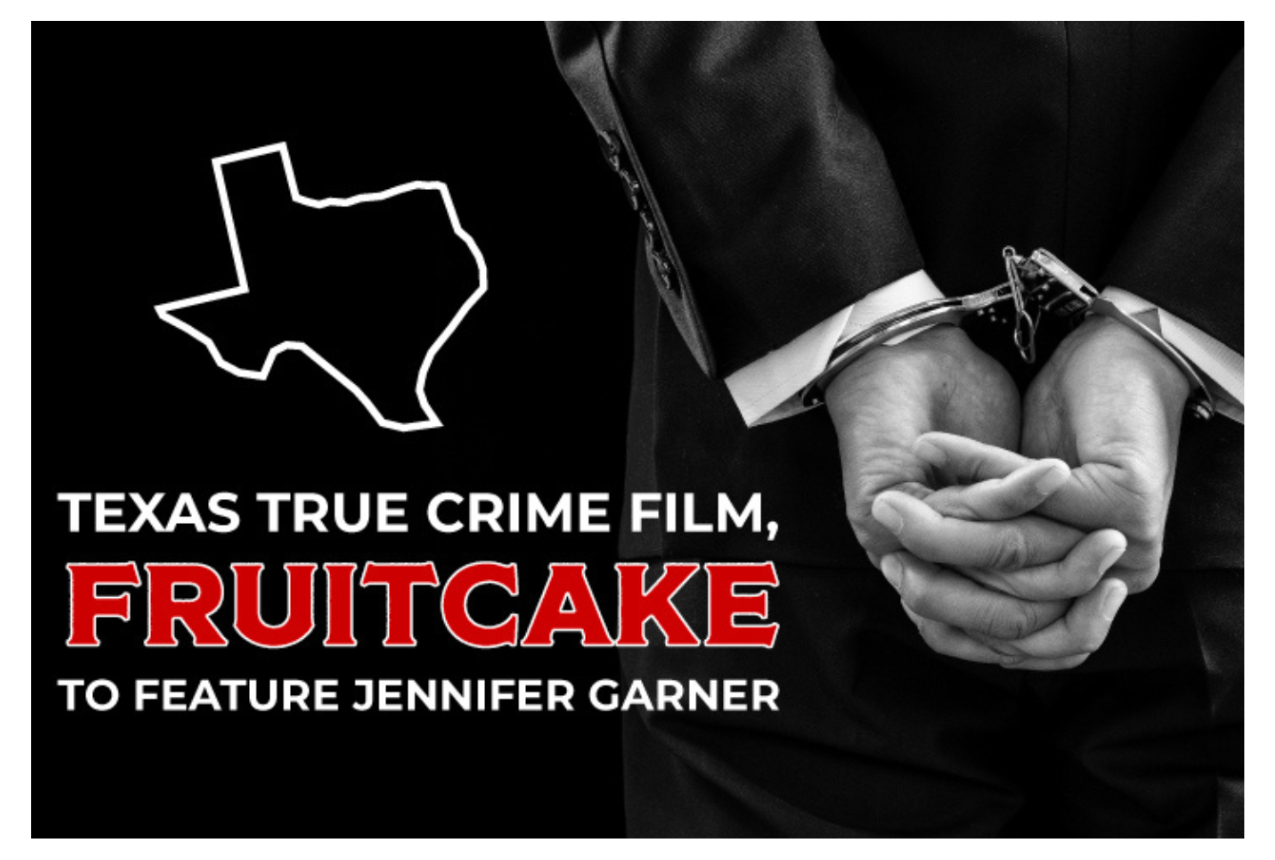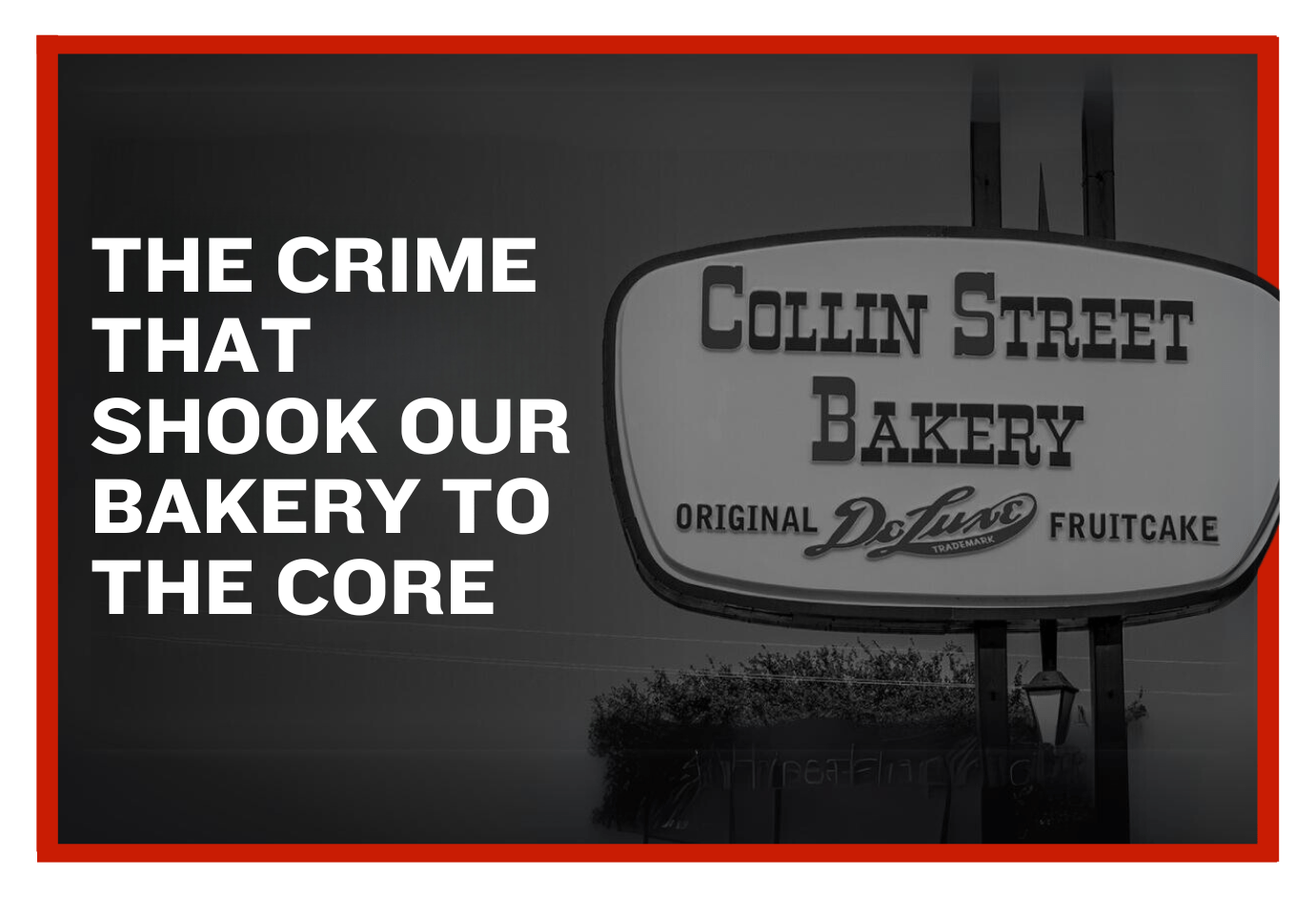How Collin Street Bakery Made a Cameo in One of the Biggest Films of All Time
IMPORTANT: This article contains movie spoilers
The year 2022 marked the 50th Anniversary of the release of one of the most iconic films in American cinema—The Godfather. The story chronicles the lives of an extraordinarily tight-knit and influential Italian family living in New York in the 1940s. Directed by Francis Ford Coppola and starring the now highly-recognizable figures of Al Pacino, James Caan, and Diane Keaton, the film ranks as perhaps one of the most quintessential movies of all time. The film was so well received, that audiences' clamor for more spurred the creation of two additional films, making The Godfather one of the most highly recognizable trilogies in history.
Unbeknownst to many, the film franchise holds a place very near and dear to Collin Street Bakery’s hearts, as our own DeLuxe® Fruitcake played a special cameo in the trilogy’s first installment. In the scene where Sonny (James Caan) learns his father, Vito Corleone has been shot, our traditional Lone Star Tin can be seen on the counter just beside his elbow. One of the set designers felt our tin brought to the scene a sense of "classic Americana" and added it without Collin Street’s knowledge. Despite this lack of forewarning, Collin Street is ecstatic to have played a small role in such a mammoth film.
So, in honor of this landmark film, this landmark year, and our special appearance, we’re taking a look back to learn more about what inspired the film, how it was created, and how it has become a cultural touchstone in American theater.
 Mario Puzzo, author of The Godfather—Artnet.com
Mario Puzzo, author of The Godfather—Artnet.com
The Novel That Inspired The Godfather
The script for The Godfather was adapted from an award-winning novel sharing the same name. Written by Mario Francis Puzo in 1969, the story chronicles the life of a fictional Mafia family living in New York City and led by the family’s patriarch, Vito Corleone. The novel spans ten years and even includes flashbacks to Corleone’s early childhood and adulthood.
Puzo was born in “Hell’s Kitchen,” a district of New York City heavily populated by Italian immigrants. Yet, he claims his inspiration for the story came from research into organized crime, not from personal experience. Despite the book’s lack of first-hand knowledge, the novel became a literary sensation, selling over nine million copies in two years and landing it on The New York Times Best Seller list, where it remained for the next sixty-seven consecutive weeks.
Shortly after its publication, the novel found its way onto the desk of Paramount Pictures’ Literary Scout & Production Vice President, Peter Bart. Inspired by the cinematic shift brought on by the wildly violent and sexualized 1967 film Bonnie and Clyde, Bart believed Puzo’s novel could be the foundation for a fast and cheap gangster-themed box-office hit. Little did Bart know the magnitude of the film that would be produced.
 Mario Puzo's novel The Godfather with Coppola's hand-written notes inside the margins—Den of Geeks
Mario Puzo's novel The Godfather with Coppola's hand-written notes inside the margins—Den of Geeks
Puzo sold his famous work to Paramount Pictures for $50,000. Adjusted for inflation, this would equate to $425,000 in 2022. Throughout the filming of the picture, Coppola kept Puzo nearby, using him as a creative collaborator and key sounding board for ideas. Notably, Coppola held great respect for all writers and always made it a point to feature the original author’s name above the title of the movies based on their works. He was famously quoted as saying:
"That’s why his name is above the title. It says: ‘Mario Puzo’s The Godfather,’ but it doesn’t say ‘Francis Ford Coppola’s The Godfather,’ because he created it. If you look at all my pictures, you’ll always see I put the writer above the title. It’s ‘John Grisham’s The Rainmaker,’ and it’s ‘Bram Stoker’s Dracula.’ And, it really should be ‘John Milius’ Apocalypse Now.’ Because the writer does the heavy lifting.”
While today, the name “Coppola” is synonymous with The Godfather, he wasn’t Paramount’s first pick for director. In fact, he wasn’t even on their top ten list.
The studio’s first choice was Italian-American director Sergio Leone. However, Leone was preoccupied with directing his own gangster film, Once Upon a Time in America, and therefore turned down the offer. Paramount then approached nine other directors, including Peter Bogdanovich, Peter Yates, Richard Brooks, Arthur Penn, Costa-Gavras, Otto Preminger, Elia Kazan, Fred Zinnemann, Franklin J. Schaffner, and Richard Lester, before landing on the then-novice director Francis Ford Coppola.
In 1969, when the film was being specced, Coppola was still a Hollywood up-and-comer, having only one notable achievement under his belt—the successful direction of the 1968 musical Finian’s Rainbow. The decision to hire Coppola was two-fold—he was willing to take a significant pay cut to direct the film, and his last name ended in a vowel. The inference was that Coppola was of Italian descent and, therefore, fit the advertising strategy Paramount was determined to present. The film was to be positioned as the first Italian mob drama made by an Italian director. With Coppola as the director, this ad campaign would be made possible.
 Francis Ford Coppola during the filming of The Godfather—TCM
Francis Ford Coppola during the filming of The Godfather—TCM
Shortly after hiring Coppola, Paramount ran into its second issue. When the rights to the story were purchased from Puzo, the novel was still fairly new. Its immediate success was alluring, as was the studio’s prediction of widespread interest in the adaptation of the story from print to the big screen. However, as word circulated about the movie’s creation, the studio began questioning its ability to deliver a film that met with audiences’ growing expectations. The film was almost dropped as a result of these concerns.
Troubles regarding the film didn't stop there. For the entire duration of the movie’s creation, the studio encountered issue after issue. These ranged from threats from well-known gangsters to friction between Coppola and Paramount executives relating to everything from casting choices, set design, and set location.
 Joseph Anthony "Joe" Colombo Sr., Founder of the Italian-American Civil Rights League—American Mafia History
Joseph Anthony "Joe" Colombo Sr., Founder of the Italian-American Civil Rights League—American Mafia History
The Mafia’s Reception of The Godfather
While the marketing campaign presented by the studio was intended as an homage to those of Italian descent, its reception by the Italian-American community was far from warm. Continuously portrayed as criminals and mobsters, groups of Italian-Americans rallied to protest the film’s creation.
Ironically enough, one of the most adamant protestors of the film was Joseph Colombo, the notorious crime boss of the Colombo family and one of the Five Families of the American Mafia located in New York City. Colombo also bristled at phrases used in Puzo’s novel and later adapted for the screen. Phrases like “sleeping with the fishes” and “going to the mattresses” came from the Gallo-Profaci wars, the decades-long altercation that took place in the 1960s between the Gallo family and the Profaci family (later to become known as the Colombo family).
Partly in an attempt to manipulate the studio and partly to mislead FBI investigators savvy to his crimes, Colombo created The Italian-American Civil Rights League and demanded words such as “Mafia” and “Cosa Nostra” be removed from the script. The League held rallies around the city, including one at Madison Square Garden, which raised $500,000 to stop production.

However, illegal tactics were also employed, including stealing a truck with a million dollars worth of film equipment from a set in Little Italy where Coppola was conducting a test shoot. Colombo also had producer Al Ruddy stalked and even threatened Paramount’s executive Robert Evan's wife and son. And twice, Paramount offices were evacuated for bomb threats.
Finally, it was decided that filming could not continue under these circumstances, leading producer Al Ruddy to arrange a meeting with Colombo. In a Park Sheraton Hotel, Ruddy conceded to removing the only use of the word “Mafia” from the script causing Colombo to bestow his blessing upon the film. In an almost comical turn of events, once Colombo no longer publicly denounced the film, mobsters started showing up on set to watch production and meet the cast. This strongly impacted the film’s trajectory as actors like Caan and Brando became comfortable enough with gangsters like Andrew “Andy Mush” Russo to ask them for elocution lessons and acting prompts.
FUN FACT #1: "Puzo actually invented the term 'godfather' as a term of mobster respect.” —The Godfather Effect, written by Tom Santopietro, Casting & Character Inspiration for The Godfather
Luckily, when casting for the movie began, Coppola and Puzo had shared visions for whom they wanted to play each key role. However, securing their actors of choice was easier said than done. The studio had its own vision for who would play each part, and it did not correspond with the film’s director or the script’s author's ideas.
 Marlon Brando as Vito Corleone in The Godfather—Vanity Fair (from Paramount/Kobal/Shutterstock)
Marlon Brando as Vito Corleone in The Godfather—Vanity Fair (from Paramount/Kobal/Shutterstock)
Marlon Brando as Vito Corleone
For the role of Vito Corleone, Coppola and Puzo wanted Marlon Brando. Brando, originally a Broadway actor, had been criticized for leaving the stage to pursue a film career. However, when he appeared as the daringly seductive Stanley Kowalski in the 1951 rendition of Tennessee Williams’ A Streetcar Named Desire, critics changed their tune. Despite ample evidence proving his multifaceted talents, the studio was not sold on casting Brando. Instead, they wanted Laurence Olivier, the eloquent Englishman known for Shakespearean acting abilities.
The studio wasn't the only one with doubts about Brando’s participation in the film. Brando himself was hesitant to audition. However, a combination of flattery and outright trickery soon secured his spot in the production. Puzo admitted to sending Brando a personal letter saying he was the “only actor who can play the Godfather,” while Coppola fooled Brando into accidentally participating in a screen test for Paramount President, Stanley Jaffe. Ultimately, Brando agreed to do the film, and for free.
FUN FACT #2: Coppola’s wife, mother, father, and two sons all appeared as extras in the picture. His father, Carmine Coppola, is credited with writing some of the movie’s scores and can even be seen playing the piano in the background of one scene.
 Al Pacino as Michael Corleone in The Godfather—Town and Country Magazine
Al Pacino as Michael Corleone in The Godfather—Town and Country Magazine
Al Pacino as Michael Corleone
For the role of Michael Corleone, the returning WWII vet and college graduate, Coppola and Puzo wanted the yet-to-be-famous Al Pacino. But, because in the book, Michael is portrayed as tall and blonde, the studio wanted Robert Redford.
When Pacino came to screen test for the part, he hadn’t memorized the scene, causing Puzo to pull his initial support for the novice actor. Ultimately, Pacino won over casting director Fred Roos by agreeing to do the part for only $35,000.
FUN FACT #3: Pacino's role in The Godfather ended up being so extraordinary, that it’s often credited with launching his career from virtual obscurity to stardom. Pacino was so adept at portraying a ruthless Italian mobster that it won him roles in the 1983 production of Scarface.
 Michael Corleone (Al Pacino) & Sonny Corleone (James Caan) in The Godfather—RollingStone (Paramount Pictures)
Michael Corleone (Al Pacino) & Sonny Corleone (James Caan) in The Godfather—RollingStone (Paramount Pictures)
James Caan as Sonny Corleone
James Caan originally screen-tested for the role of Michael Corleone. However, Caan’s style of acting was too improvisational and emotional and, therefore, unfitting for the part of the calm, composed Michael. Coppola realized Caan would be far more fit to play Sonny, the rash and dramatic brother who acts before he thinks, nearly destroying his family in the process. Ultimately, Caan filled the role perfectly. His knack for choosing the right moments to launch off-script often elicited authentic surprise and alarm from cast members. In fact, in the scene where Sonny fights his brother-in-law, Carlo Rizzo, Caan breaks fellow actor Gianni Russo’s ribs when he spontaneously and without warning hurls a garbage can.
According to Caan, one of his inspirations for Sonny’s brash, chaotic nature was insult comedian Don Rickles. Oftentimes, Caan became so wrapped up in his character, that he’d randomly improvise his lines. Frequently, Coppola would keep these ad-libs in the film's final edits. Among these was Caan’s ad-lib of the phrase “bada bing.”
Mark Seal, author of Leave the Gun, Take the Cannoli, a book published in 2021 examining how The Godfather came together despite a constant stream of setbacks, said, “James Caan’s fiery portrayal of Sonny will surely be remembered as one of the greats, as evidenced by what Caan told me about how people would test him in public to see if he would react like Sonny Corleone.”
Sadly, James Caan recently passed away. He died at Ronald Reagan UCLA Medical Center in Los Angeles on July 6, 2022, at the age of 82. His passing was caused by a heart attack resulting from a long-standing battle with coronary artery disease. Some of his most notable roles include Brian Piccolo in Brian’s Song, Walter Hobbs in Elf, and, of course, Sonny Corleone in The Godfather.
The Godfather’s Production Budget
For Coppola to achieve his vision for The Godfather, he requested a $5 million budget and an eighty-day shooting schedule. Paramount, having recently produced a box office flop with the 1969 film The Brotherhood, initially rejected the suggestion. The Brotherhood was widely criticized for key actors Kirk Douglas’ and Alex Cord’s unbelievable portrayal of Italians. Therefore, the studio was reluctant to sink too much money into an organized crime flick and suggested moving filming to Kansas City to cut costs. However, Coppola remained firm on his request. The studio counter-offered, agreeing to pay Coppola’s requested dollar figure, but with the contingency that filming was to be capped at fifty-three days.
Unfortunately, Coppola was now under Paramount’s thumb to produce a high-quality film on budget and on time. This meant the studio’s Vice President, Jack Ballard, was constantly hovering, closely watching the till. Paramount’s sizable financial contribution also meant executives felt they had the right to question Coppola at every turn.
Throughout the entirety of filming, Coppola's creative direction was critiqued, and oftentimes various heads would threaten to fire the director. Luckily, both Brando and Pacino believed their director’s vision, counter-threatening to quit if Coppola was removed from the project. The studio even made it known that Elia Kazan, the highly respected Turkish-born director, was in the wings to take Coppola’s place at any point in time.
It wasn’t until the scene where Michael Corleone, played by Al Pacino, shoots Sollozzo and McCluskey while at dinner that Paramount realized Coppola might have a knack for producing the kind of film they were pursuing. After that, the studio relaxed, allowing filming to continue uninterrupted.
 Marlon Brando in the makeup chair becoming Vito Corleone—Den of Geek
Marlon Brando in the makeup chair becoming Vito Corleone—Den of Geek
Turning Marlon Brando into The Godfather
Turning Marlon Brando from a stunningly handsome heartthrob into a bulldog-faced mob boss was not an easy feat. It required several hours each day in the makeup chair, as well as a handful of out-of-the-box tricks to create the appearance of the aged Mafia ring leader. Fake lower dentures were used to create a predominantly jowly appearance, and body pads were strategically placed inside Brando’s wardrobe to make him look more paunchy. Brando also requested his shoes be weighted with lead in order to remove the spring from his step. Lastly, earplugs were worn to help reduce background noise, requiring Brando to stay intensely hyper-focused on whomever he was speaking.
Bringing Vito Corleone to life was all Brando. Corleone’s subtle gestures and raspy breath were derived from Brando’s imagination and became signatures of his iconic character. When it came to Corleone’s more nuanced mannerisms, Brando leaned into past personal experiences.
Known for using a method acting style called the Stanislavski system, Brando channeled his troubled childhood to recall real emotions of anger, disappointment, and sadness. These authentic emotions were then redirected into his characters. Brando once stated, “If I have a scene to play and I have to be angry, I can remember my father hitting me."

This method made him a highly-respected actor, as many of his characters’ emotions rang true. Unfortunately, while this ability to recall trauma benefitted him in his professional career, it harmed him in his personal life. Brando earned himself a reputation for being hostile and difficult, a by-product of growing up physically abused and emotionally underdeveloped at the hands of two alcoholic parents.
Fun Fact #4: Oranges play a subtle yet significant role throughout The Godfather Trilogy. Typically found in a scene just preceding a gruesome murder, film critics noted oranges seemed to indicate danger and inevitable doom.
Per Dean Tavoularis, the film’s production designer, this coincidence was just that. In author Harlan Lebo’s 1997 book, The Godfather Legacy, he quoted Tavoularis saying, “I don’t remember anybody saying ‘Hey, I like oranges as a symbolic message.’ Oranges just look nice in low lighting.”
Filming The Godfather
Just as Paramount’s studio executives were concerned The Godfather would fail, so was Coppola. The root of his concerns derived from a new style of filming he was determined to leverage, even though it fell outside of the typical formula for Hollywood movies of the era.
"I thought it was going to be a special failure. When you make a film going against the grain of what’s going on at the time, those kinds of films are tough. You’re not doing what everyone expects or wants you to do.”
The Godfather is largely shot in what’s called a “tableau format.” This is where people and objects are arranged within a static scene, almost presented like paintings in a frame. This style of shooting is rather specific, as a well-done tableau shot presents an artful image you could capture in a photo to hang on a living room wall.
The style of shooting wasn’t the only innovation Coppola employed. A stickler for accuracy and realism in all aspects of the film, Coppola insisted on authentic period-specific background props and even accurate portrayals of mob violence. The latter was considered cutting edge for two primary reasons—such outright and focused displays of violence were atypical for the time, and to capture the appearance of violence without harming anyone in the process was an art that had yet to be honed. Therefore, less-practiced, finicky tactics had to be used.

The reason for the necessity of these innovations links back to the style of filming employed. Unlike other films, quick cuts were not used to conceal violence. Still shots tightly focused on the gore, eliciting a highly visceral reaction from the audience. Take, for example, the scene in which Michael Corleone takes revenge on a rival Mafia member and the police captain.
To achieve the desired effect, the crew secured a squib, also known as an exploding fake blood packet, onto the forehead of Michael's to-be victims. A trigger wire was then connected to the squib and concealed by the actor’s hair. When the prop gun was fired, a crew member would trigger the squib, bursting the packet and leaving a visual “hole” on the victim’s forehead. The result was a highly realistic and gruesome effect. In Jenny Jones’s 2007 book, The Annotated Godfather, she quotes Coppola as having said this scene was “the biggest scene in the movie, effect-wise.” Special effects supervisor A.D. Flowers also recalled similar ingenuity required for a different, yet equally gory scene.
Towards the end of the film, when Casino owner Moe Green is shot through his eyeglasses, special lenses are made to create as realistic an effect as possible. This was accomplished by lining the temple of the eyeglass with two tiny tubes that threaded behind the actor’s body. The first tube was filled with a BB-sized ball bearing that when filled with compressed air, would shoot the ball bearing out into the glasses, cracking the lens. The second tube was then filled with syrupy red liquid, finishing the effect with a geyser of fake blood. Flowers had admitted to previously trying something similar in other films, but the effect was unsuccessful till The Godfather.

While these senses required finesse and nuance, they were not the most aggressive. Arguably, the most violent scene takes place when Sonny Corleone is gunned down outside a toll booth. The scene required hundreds of squibs placed not only on Caan’s character but also drilled into the car and toll booth. The wires were then threaded down Caan’s pants, which is why you never see Sonny’s feet in the film’s final edits. This scene was completed in one take and cost over $100,000 to produce—$708,000 in 2022 dollars.
“The essence of cinema is editing. It’s the combination of what can be extraordinary images of people during emotional moments, or images in a general sense, put together in a kind of alchemy.” — Francis Ford Coppola
Editing The Godfather
When filming concluded, it was determined more than 500,000 feet or ninety hours of usable footage had been filmed. Editing of this material was divided between six people, yet only two were credited—William Reynolds and Peter Zinner. Accordingly to Harlan Lebo, author of The Godfather Legacy, “Coppola repeatedly removed and replaced scenes, often to “appease the studio,” resulting in the edit becoming a “maze,” with multiple scenes sliced and abandoned on the cutting room floor.” Despite the tedious nature of editing, the jaw-dropping results of this process cannot be denied.
A review written by Sarah Rivka, in a U.C. Berkeley article entitled “Navigating Coppola’s Maze: Editing in The Godfather” states, “The Godfather lulls the audience into submission in order to intensify the impact of violent action when it arrives. The rhythm of the film’s editing thereby mirrors the rhythm of the Corleone family, which strives to maintain an equilibrium, but often resorts to violence in order to reach it.” Ultimately, the film epitomizes the phrase “it’s calmest before the storm.”
Public Reception of The Godfather
The Godfather first debuted on March 24, 1972. The public reception of the film was astounding, raking in more than $1 million on its first day—the most any film to date had made in a single day. The reasons for the success of the film were multi-faceted. Not only was the book an all-time best seller, creating anticipation and buzz, but pre-reviews of the film published in advance of its release sang the movie’s praises. In a review published on March 16, 1972, in The New York Times, film critic Vincent Canby wrote, “Francis Ford Coppola has made one of the most brutal and moving chronicles of American life designed within the limits of popular entertainment.”
In total, The Godfather grossed a whopping $136.9 million at the box office—that equates to $970.5 million in 2022.
The Godfather Nominations & Awards
The list of nominations received by The Godfather just barely surpassed its list of awards. During the 1973 award season, the film received nominations from almost every major award organization and in almost every major award category. Most notably, the film won Oscars for Best Picture, Best Actor in a Leading Role (Marlon Brando), and Best Writing (Mario Puzo & Francis Ford Coppola). Additionally, the film won Golden Globes for Best Motion Picture, Best Actor (Marlon Brando), Best Director (Francis Ford Coppola), Best Screenplay (Mario Puzo & Francis Ford Coppola), and Best Original Score (Nino Rota).
Fun Fact #5: Al Pacino was nominated for an Oscar for Best Actor in a Supporting Role. But, as a form of protest, refused to attend the awards ceremony. He believed there was category fraud, stating his character, Michael Corleone, had more screen time than co-star Brando. Pacino thereby felt he should have been the one to receive a nomination for Best Actor in a Leading Role.
The Godfather Trilogy
Due to the immense success of The Godfather, Paramount decided to back the creation of a sequel, keeping Coppola as its director. Two years later, The Godfather Part II was released to mixed reviews. Undoubtedly because of the immense success of its first installment, the second film failed to meet expectations, leading to a rather mixed bag of reviews.
A scathing article published on January 1, 1974, written by Roger Ebert of the Chicago Sun-Times read, “There’s evidence in the film that Coppola never completely mastered the chaotic mass of material in his screenplay… What we’re left with, then, are a lot of good scenes and good performances set in the midst of a mass of undisciplined material and handicapped by plot construction that prevents the story from ever really building.” Yet, a contradictory review written by Dan Jardine of the Apollo Movie Guide stated that The Godfather Part II was “The mother of all sequels: a film at once both greater and lesser than its predecessor.”
Almost a decade and a half later, the third and last installment of The Godfather was released with The Godfather: Part III. Both Coppola and Puzo wanted to title the movie “The Death of Michael Corleone.” However, Paramount fully rejected the suggestion. Just like the second film, the last of the trilogy was met with a divided response.
Despite all the reviews, both positive and negative, The Godfather Trilogy remains in public opinion as one of the most iconic movies of all time. The American Film Institute even ranks Parts I & II on their list of “100 Greatest American Movies of All Time.” Together, these films received twenty-eight Academy Award nominations, winning nine
The Godfather: A Lasting Legacy
Regrettably, many of the actors that played in the film series have since passed on. However, their acting legacy lives on today thanks to Coppola and his vision for the iconic trilogy. The film series undoubtedly paved the way for modern-day cinematography and lives today as a benchmark for film success.
Francis Ford Coppola, now eighty-one years old, was honored as the 2,715th celebrity to receive his star on the Hollywood Walk of Fame on March 21, 2022. Ana Martinez, producer of the Hollywood Walk of Fame said, “Francis Ford Coppola is cinematic gold! His legendary career has been a huge part of Hollywood’s film history for decades. We are very proud to welcome him to the Hollywood Walk of Fame, and we are thrilled to celebrate the 50th anniversary of one of Hollywood’s most famous films, The Godfather.”
FUN FACT #6: Nicolas Cage is the nephew of Francis Ford Coppola
Try the Famous Godfather Fruitcake
Expertly crafted for over 125 years, there's a reason why our fruitcake is called the DeLuxe®. Superior to all others in taste and texture, there’s no wonder why it was featured in one of the most iconic films of all time. Order our DeLuxe® Fruitcake today to taste the cake good enough for the Corleones. Or, head on over to our specials page to see our latest deals. There, you might find an offer you can’t refuse.
















Leave a comment
This site is protected by hCaptcha and the hCaptcha Privacy Policy and Terms of Service apply.